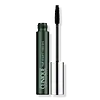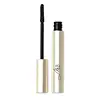What's inside
What's inside
 Key Ingredients
Key Ingredients

No key ingredients
 Benefits
Benefits

 Concerns
Concerns

 Ingredients Side-by-side
Ingredients Side-by-side

Water
Skin ConditioningCopernicia Cerifera Wax
Stearic Acid
CleansingGlyceryl Stearate
EmollientPolyisobutene
Silica
AbrasiveAcrylates Copolymer
Aminomethyl Propanediol
BufferingVp/Eicosene Copolymer
Sodium Hyaluronate
HumectantLauroyl Lysine
Skin ConditioningPantethine
EmollientMelanin
Skin ProtectingPanthenol
Skin ConditioningEthylhexylglycerin
Skin ConditioningHydroxyethylcellulose
Emulsion StabilisingCalcium Aluminum Borosilicate
Pvp
Emulsion StabilisingAcacia Senegal Gum
MaskingIsostearic Acid
CleansingSimethicone
EmollientDimethicone PEG-8 Polyacrylate
Urea
BufferingGlycerin
HumectantPentaerythrityl Tetra-Di-T-Butyl Hydroxyhydrocinnamate
AntioxidantSodium Lauryl Sulfate
CleansingPEG-8 Dimethicone
EmulsifyingDisodium EDTA
Sorbic Acid
PreservativeChlorphenesin
AntimicrobialSodium Dehydroacetate
PreservativePhenoxyethanol
PreservativeMica
Cosmetic ColorantCI 77491
Cosmetic ColorantCI 77492
Cosmetic ColorantCI 77499
Cosmetic ColorantCI 77400
Cosmetic ColorantCI 42090
Cosmetic ColorantCI 77891
Cosmetic ColorantCI 19140
Cosmetic ColorantCI 77288
Cosmetic ColorantCI 77289
Cosmetic ColorantCI 75470
Cosmetic ColorantCI 77163
Cosmetic ColorantCI 77007
Cosmetic ColorantCI 77000
Cosmetic ColorantWater, Copernicia Cerifera Wax, Stearic Acid, Glyceryl Stearate, Polyisobutene, Silica, Acrylates Copolymer, Aminomethyl Propanediol, Vp/Eicosene Copolymer, Sodium Hyaluronate, Lauroyl Lysine, Pantethine, Melanin, Panthenol, Ethylhexylglycerin, Hydroxyethylcellulose, Calcium Aluminum Borosilicate, Pvp, Acacia Senegal Gum, Isostearic Acid, Simethicone, Dimethicone PEG-8 Polyacrylate, Urea, Glycerin, Pentaerythrityl Tetra-Di-T-Butyl Hydroxyhydrocinnamate, Sodium Lauryl Sulfate, PEG-8 Dimethicone, Disodium EDTA, Sorbic Acid, Chlorphenesin, Sodium Dehydroacetate, Phenoxyethanol, Mica, CI 77491, CI 77492, CI 77499, CI 77400, CI 42090, CI 77891, CI 19140, CI 77288, CI 77289, CI 75470, CI 77163, CI 77007, CI 77000
Water
Skin ConditioningGlyceryl Stearate
EmollientHydroxypropyl Starch
Copernicia Cerifera Wax
Glycerin
HumectantButyrospermum Parkii Butter
Skin ConditioningStearic Acid
CleansingPalmitic Acid
EmollientDextrin Isostearate
Skin ConditioningMica
Cosmetic ColorantTromethamine
BufferingPvp
Emulsion Stabilising1,2-Hexanediol
Skin ConditioningCaprylyl Glycol
EmollientCaprylic/Capric Triglyceride
MaskingAluminum Hydroxide
EmollientSodium Dehydroacetate
PreservativeXanthan Gum
EmulsifyingPentylene Glycol
Skin ConditioningPlankton Extract
Skin ConditioningCI 77491
Cosmetic ColorantCI 77499
Cosmetic ColorantCI 77492
Cosmetic ColorantCI 77891
Cosmetic ColorantWater, Glyceryl Stearate, Hydroxypropyl Starch, Copernicia Cerifera Wax, Glycerin, Butyrospermum Parkii Butter, Stearic Acid, Palmitic Acid, Dextrin Isostearate, Mica, Tromethamine, Pvp, 1,2-Hexanediol, Caprylyl Glycol, Caprylic/Capric Triglyceride, Aluminum Hydroxide, Sodium Dehydroacetate, Xanthan Gum, Pentylene Glycol, Plankton Extract, CI 77491, CI 77499, CI 77492, CI 77891
Ingredients Explained
These ingredients are found in both products.
Ingredients higher up in an ingredient list are typically present in a larger amount.
Ci 77491 is also hydrated iron III oxide. It's sole purpose is to give a red/pink hue to products.
Iron III oxides are classified as inorganic chemicals for coloring.
Synthetically created Ci 77491 is considered safer than those naturally found. This is because the synthetically created version may contain less impurities. Iron oxides are generally non-toxic and non-allergenic.
Learn more about CI 77491Ci 77492 is also hydrated iron III oxide. It's sole purpose is to give a yellow hue to products.
Iron III oxides are classified as inorganic chemicals for coloring.
Synthetically created Ci 77492 is considered safer than those naturally found. This is because the synthetically created version may contain less impurities. Iron oxides are generally non-toxic and non-allergenic.
Learn more about CI 77492Ci 77499 is also hydrated iron III oxide. It is created from mixing red and black iron oxides. This helps give shades of darkness to a product.
Iron III oxides are classified as inorganic chemicals for coloring.
Ci 77891 is a white pigment from Titanium dioxide. It is naturally found in minerals such as rutile and ilmenite.
It's main function is to add a white color to cosmetics. It can also be mixed with other colors to create different shades.
Ci 77891 is commonly found in sunscreens due to its ability to block UV rays.
Learn more about CI 77891Copernicia Cerifera Wax comes from a palm tree native to Brazil; another name for this ingredient is Carnauba Wax.
This ingredient is used to thicken texture and also leaves behind a film when applied.
Fun fact: This wax has the highest melting point of all natural waxes and low solubility.
Learn more about Copernicia Cerifera WaxGlycerin is already naturally found in your skin. It helps moisturize and protect your skin.
A study from 2016 found glycerin to be more effective as a humectant than AHAs and hyaluronic acid.
As a humectant, it helps the skin stay hydrated by pulling moisture to your skin. The low molecular weight of glycerin allows it to pull moisture into the deeper layers of your skin.
Hydrated skin improves your skin barrier; Your skin barrier helps protect against irritants and bacteria.
Glycerin has also been found to have antimicrobial and antiviral properties. Due to these properties, glycerin is often used in wound and burn treatments.
In cosmetics, glycerin is usually derived from plants such as soybean or palm. However, it can also be sourced from animals, such as tallow or animal fat.
This ingredient is organic, colorless, odorless, and non-toxic.
Glycerin is the name for this ingredient in American English. British English uses Glycerol/Glycerine.
Learn more about GlycerinGlyceryl Stearate is a mix of glycerin and stearic acid.
It is used to stabilize the mixing of water and oil ingredients. By preventing these ingredients from separating, it can help elongate shelf life. It can also help thicken the product's texture.
As an emollient, it helps soften skin and supports barrier-replenishing ingredients.
In cosmetics, Glyceryl Stearate is often made from vegetable oils or synthetically produced.
This ingredient may not be fungal-acne safe
Fun fact: The human body also creates Glyceryl Stearate naturally.
Learn more about Glyceryl StearateMica is a naturally occurring mineral used to add shimmer and color in cosmetics. It can also help improve the texture of a product or give it an opaque, white/silver color.
Serecite is the name for very fine but ragged grains of mica.
This ingredient is often coated with metal oxides like titanium dioxide. Trace amounts of heavy metals may be found in mica, but these metals are not harmful in our personal products.
Mica has been used since prehistoric times throughout the world. Ancient Egyptian, Indian, Greek, Roman, Aztec, and Chinese civilizations have used mica.
Learn more about MicaPvp is a water-soluble synthetic polymer and common hairstyling ingredient. It is a film-forming ingredient and used to "hold" specific shapes of hair.
Pvp is less effective in high-humidity. It tends to draw moisture, but this moisture dismantles the structure and "hold".
This ingredient is a preservative with antimicrobial properties. It is the sodium salt of dehydroacetic acid.
It is especially effective at preventing bacterial and fungal growth in low concentrations.
Stearic Acid is a fatty acid. It is an emollient, emulsifier, and texture enhancer.
As an emollient, stearic acid helps soften skin. It aids the skin's protective barrier by preventing water loss. It also provides a gentle cleansing effect without stripping away natural oils.
Stearic acid may also be used to enhance the texture of products. It can add volume and stabilize ingredients such as water and oil. This can help water and oil ingredients from separating.
Sources of stearic acid include animal or vegetable fats/oils such as coconut or shea. It can be naturally found in butter, cocoa butter, shea butter, vegetable fats, and animal tallow.
This ingredient may not be Malassezia folliculitis, or fungal-acne safe.
Learn more about Stearic AcidWater. It's the most common cosmetic ingredient of all. You'll usually see it at the top of ingredient lists, meaning that it makes up the largest part of the product.
So why is it so popular? Water most often acts as a solvent - this means that it helps dissolve other ingredients into the formulation.
You'll also recognize water as that liquid we all need to stay alive. If you see this, drink a glass of water. Stay hydrated!
Learn more about Water